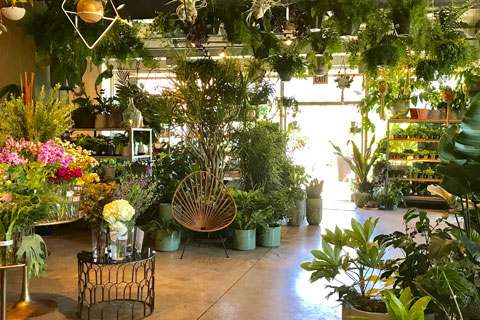1/1/2018
The Modern Landscape
Ellen C. Wells

There is a lot that’s new in terms of how modern consumers are interacting with the spaces they live in and that surround them. Sprawling back yards do exist but a growing population means more and more people are relegated to smaller living spaces—both inside and out. They’re also attempting to simplify their lives by bringing as much of it as possible under the control of their smartphones. Let’s examine how “tech and tiny” are changing what’s in your garden center’s landscape department.
The New Tech
When we think “modern” we think technology. Digital, automated and robotic tech have the potential to change how we interface with the landscape and landscaping—and that change is coming fast. Digital technology is already helping landscape designers sketch preliminary layouts via landscape design apps on tablets. “There are all sorts of programs that are design tools,” says Mason Day, cofounder of the social gardening app GrowIt! “You can design a yard on an iPad right there and give your client an idea of what it would look like without having to go back to the office.”
Digital tech also allows potential clients to see the landscapers’ previous work. The Houzz website, for example, allows homeowners to search out vendors of all sorts within their area. A landscaper can fill a Houzz profile with examples of their work and other information of value to the viewer. Previous clients weigh in with ratings and comments. “The best landscapers are using Houzz and they realize the customers coming out of there are high-end,” says Mason. “They are the customers landscapers want—people who have enough money to do significant work and looking for hardscapes and plants.”
That digital technology also will help us irrigate, fertilize and mow. Mason sees a lot of opportunities for connected devices taking control of our routine landscape care. “When people are looking for sprinklers and those types of systems, they’ll want to tie them into what they already have inside the home, like Google Home,” he says. “They’ll figure out how to coordinate it so they don’t really have to think about turning on the sprinkler system. They can just press a button on the phone.” Mason points to the Scotts Miracle-Gro app called Gro, which will be the platform for connecting automated irrigation and plant monitoring tools. He estimates this connected landscape monitoring could be about two to five years away.
That smartphone can also control the robotic critter hungrily mowing the lawn. While robotic powerhouse iRobot is yet to enter the market, there are a bunch of companies already in the landscaping space that do have robotic mowers, including Honda and Husqvarna.
The New Landscape
For many homeowners the only landscape opportunities that present themselves are those inside the home or on a balcony or roof top. No 1-acre spreads with robotically mowed lawns, manicured gardens, fencing or app-controlled lawn irrigation features here. Folks with only an interior wall, sunny room or terrace should not be denied the ability to express their “landscape” creativity. If the modern landscape incorporates these small spaces, then the modern landscape department must include plants and products to meet the demand.
Christy Webber Farm and Garden is a garden retailer in the heart of Chicago and caters to customers who live in condominiums, apartments and townhomes. Some may even have the luxury of outdoor space on a roof deck. “We have an amazing and beautiful selection of large, well-insulated containers for rooftops and balconies,” says Renee Young, the store’s manager. “People are setting up edible gardens on rooftops all the time, so we’re really into the Earth Box and setting up permaculture gardens on the roof.” Her customers want fruit trees, but the small spaces are more suitable for espaliered and columnar trees rather than the traditional shapes.
For interior spaces, Christy Webber Farm and Garden offers what Renee calls “plug and play,” small-component living wall products. These are picture frame-sized pieces that can be planted with herbs or tropical plants.
Sprout Chicago serves the West Town neighborhood of the same city. Manager Stephen Hill’s take on their customers is, “A lot of folks who maybe didn’t think of themselves as gardeners or didn’t think they had the opportunity to garden are now realizing their indoor space is just as viable as having outdoor space.” He says that urban living areas create very specific environments within and outside a home, and their job is to use products and plants that allow their customers to use those spaces. “We tell people, ‘There’s a plant for every place.’”
In addition to the small wall-mounted “living portrait” products, Sprout Chicago offers both in-house and custom-created faux living walls. They use dried moss, lichen, floral and branches to create something decorative for use on an interior wall but doesn’t require the maintenance a living wall requires. “Sometimes people see living walls and want one, but the fact of the matter is there is a lot of work behind it that doesn’t always make it viable in the home,” Stephen explains. Plus, these faux living walls are lightweight. “As long as the wall can support a French cleat and a moss panel, you’re good to go.”
Small planters, wall-mounted planters and containers that are aesthetically pleasing are ways that Sprout Chicago meets the needs of their customers. “It’s a service and an experience,” Stephen says. “A lot of what we do—the faux living walls, for example—is in response to our customers’ needs.” GP